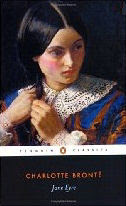Classics Challenge #2
Victorian Challenge #6
 Jane Eyre has none of the advantages that an ordinary girl might hope for. Plain, orphaned, poor, and friendless, she is dependent upon the scant goodwill of relatives by marriage who never wanted her. One thing she does have is spirit, and after showing it in spectacular fashion she is dispatched by her Aunt Reed to the bleak school at Lowood. Among the strict rules, freezing weather, and the miserable food, she finds friends and a home for the first time in her life.
Jane Eyre has none of the advantages that an ordinary girl might hope for. Plain, orphaned, poor, and friendless, she is dependent upon the scant goodwill of relatives by marriage who never wanted her. One thing she does have is spirit, and after showing it in spectacular fashion she is dispatched by her Aunt Reed to the bleak school at Lowood. Among the strict rules, freezing weather, and the miserable food, she finds friends and a home for the first time in her life.
Eight years later, having risen to the post of teacher, Jane feels it is time for a change; and common sense dictates that the way to effect one is to advertise. A letter arrives in response from a Mrs Fairfax, seeking a governess to take up residence at Thornfield Hall. The Hall is everything Jane could wish: a fine house with beautiful grounds, run by a kindly housekeeper, and with an affectionate if frivolous charge in Adele Varens. The one discordant note is the unwelcoming servant Grace Poole, and the spine-chilling laughter that comes from her rooms on the third floor. But what is one unfriendly face in a house whose master is Mr Rochester, who likes to hear Jane talk and make her laugh?
Jane knows that she could never be so lucky; that he must marry status and fortune like those possessed by Blanche Ingram. Still she cannot help but hope, until a surprise event forces her to decide what she truly wants.
It’s been way too long since I last read this. Actually, it’s been sitting in my TBR pile ever since I heard there was going to be a new adaptation. (Better late than never . . .) It was just as good the second time as the first. I liked Jane from the start - how can you not love someone who would rather curl up in a window seat with a book than go for a winter walk? And my fondness for her increased as the book continued. She is a heroine of firm principles and sticks to them regardless of what other people might think of her. She will always be one of my favourites, because that quiet strength is something I could realistically aspire to emulate.
All the hallmarks of the gothic are there: isolated heroine, old house in the middle of nowhere, mysterious owner, sinister servant, strange dreams and things which might defy explanation. It has its unnerving moments, such as Jane’s midnight encounter with Richard Mason, but it feels more like a novel with gothic overtones than an actual gothic. Jane has too much sense to let her imagination run away with her, or let Thornfield Hall’s oddities assume greater importance than her relationships with the people it contains. Chief amongst these is, of course, Mr Rochester, whose past might not be much to boast about but who at least has better intentions for the future. (But you know that they say about good intentions....) He might be devoid of looks and possessed of the habit of deriving amusement from other people, but I envy Jane her finding of someone to appreciate her for her mind above all else.
Yes, there’s a too-convenient stroke of coincidence in Jane’s meeting the Rivers siblings. And I felt that the religious aspects of Rochester’s acceptance of his fate didn’t ring quite true (though that is perhaps the confirmed atheist talking). But really, I don’t care. It’s a wonderful book, one which more than any other love story holds out the tantalising promise of a Prince Charming out there for even the poorest and plainest. (It also has the ever-interesting St John Rivers, who raises the concept of duty to a whole new level.) And it will not go another who knows how many years without a re-read.
Rating: A











1 comment:
This is one I have not gotten to yet. Someone actually recommended it to me on my blog not long ago. I am glad to see you enjoyed it.
Post a Comment